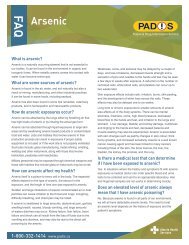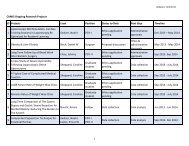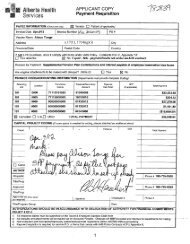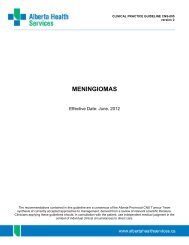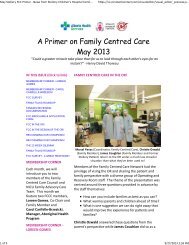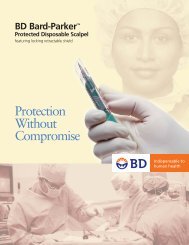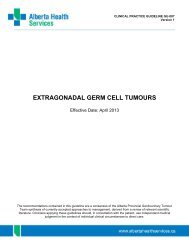Chronic Lymphocytic Leukemia - Alberta Health Services
Chronic Lymphocytic Leukemia - Alberta Health Services
Chronic Lymphocytic Leukemia - Alberta Health Services
You also want an ePaper? Increase the reach of your titles
YUMPU automatically turns print PDFs into web optimized ePapers that Google loves.
• del(17p) in 3 to 27% of patients (3)<br />
CLINICAL PRACTICE GUIDELINE LYHE-007<br />
Version 2<br />
In general, patients with a normal karyotype or isolated del(13q) can be categorized as low risk with<br />
prolonged time to disease progression and better chances of long-term survival, whereas patients with<br />
del(17p), and del(11q) are more likely to have a poor prognosis. (9) Patients with trisomy 12 have a<br />
treatment advantage over those with del(17p) or del(11q), as they tend to respond better to fludarabinebased<br />
therapy. In addition, patients with del(11q) appear to benefit from the addition of cyclophosphamide<br />
to fludarabine (FC), and do particularly well with FC plus rituximab (FCR). (10) Del(17p) leads to loss of the<br />
p53 tumour suppressor gene, which mediates cell death induced by alkylating agents and purine<br />
analogues. Hence, patients with del(17p) are typically less responsive to these agents, but may respond<br />
to agents such as alemtuzumab, flavopiridol, lenalidomide or high dose steroids. (3) FISH analysis may<br />
therefore be useful in the selection of patients with high risk disease who might benefit from allogeneic<br />
stem cell transplantation. Such patients are at high risk of treatment failure and are likely to become<br />
refractory to treatment or to relapse early after fludarabine-based therapy. (11)<br />
IgVH mutational status and VH3.21 gene usage. Approximately half of all CLL patients have leukemic<br />
cells with somatic hyper-mutations in the immunoglobulin heavy chain variable region (IgVH) genes.<br />
Patients with mutated CLL have improved survival as compared to those with unmutated CLL. (3,9) Patients<br />
with unmutated CLL exhibit faster disease progression, atypical peripheral blood cell morphology, adverse<br />
cytogenetic features, and clonal evolution. (9) The VH3.21 gene is an unfavourable prognostic marker,<br />
regardless of IgVH mutational status. (3) Sequencing of the genome required to determine IgVH mutational<br />
status is expensive, time-consuming, and not readily available for clinical purposes at most sites. There is<br />
also currently no evidence that unmutated IgVH should influence treatment decision-making.<br />
ZAP-70 and CD38 expression. In the course of identifying surrogate markers for IgVH mutational status,<br />
a small number of genes were identified that allow the separation of mutated and unmutated CLL. The<br />
most specific of these genes is the one that encodes for a 70-kD zeta-associated protein (ZAP-70). The<br />
majority of mutated CLL cases are ZAP-70 negative (defined as ≤20% positive cells), whereas unmutated<br />
forms are more often ZAP-70 positive (defined as >20% positive cells). (9) Discordance of ZAP-70<br />
expression and IgVH mutational status is reported in about 25 percent of CLL patients. (12) Positive ZAP-70<br />
predicts more rapid disease progression and poorer survival. At present, ZAP-70 analysis is hampered by<br />
variation in technique, leading to inconsistent results across centres and not routinely recommended in<br />
most centres.<br />
CD38 is an ectoenzyme involved in transmembrane signaling and cell adhesion, and can correlate with<br />
unmutated IgVH status, predicting a poor prognosis. Though easy to perform through flow cytometric<br />
techniques, CD38 is discordant with IgVH mutational status in a significant proportion of cases and<br />
variability in results over time are drawbacks for its use. (3)<br />
Serum markers. Serum markers such as CD23, thymidine kinase (TK), and ß2-microglobulin (ß2M) may<br />
predict overall- or progression-free survival (PFS). (3) Even in cases of early stage disease, serum TK<br />
levels correlate with tumour mass and proliferative activity of CLL cells. In addition, high levels of CD23<br />
are associated with diffuse bone marrow infiltration and rapid lymphocyte doubling time. Serum TK and<br />
CD23 assays are not routinely used in Canada. Alternatively, serum levels of β2M are easily available at<br />
most Canadian centres and correlate with both clinical stage and overall survival. (9)<br />
The value of prognostic markers in elderly patients is questionable with evidence suggesting that most of<br />
the reported prognostic factors are not relevant to the elderly CLL population. (13)<br />
Page 6 of 23



